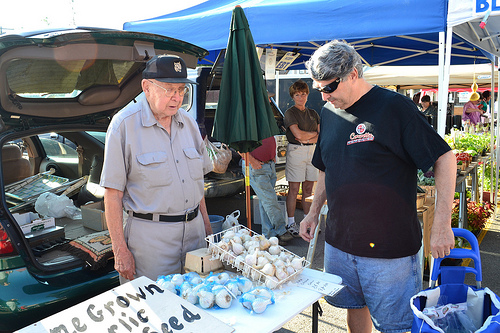There are few things more mouth-watering or nutritious than fresh produce bought near where it’s grown.
So it’s gratifying to hear that the number of local farmers’ markets listed by the US Department of Agriculture grew 9.6% in the past year, reaching 7,864 locations by early August.
The top states, accounting for more than half of the self-reported listings, are California (827), New York (647), Massachusetts (313), Michigan (311), Wisconsin (298), Illinois (292), Ohio (264), Pennsylvania (254), Virginia and Iowa (tied with 227) and North Carolina (202).
The mid-Atlantic, the Northeast, and the Southeast regions are growing the fastest with 15.8%, 14.4% and 13.1% more markets, respectively.
"Farmers markets are a critical ingredient to our nation’s food system," says Kathleen Merrigan, Deputy Secretary of Agriculture. "These outlets provide benefits not only to the farmers looking for important income opportunities, but also to the communities looking for fresh, healthy foods."

Elmer Moje has been bringing produce to the same market in Tonawanda, New York, for decades. (Photo by Sharif Hamdy)
USDA is taking several steps to help small and midsize farmers sell their crops at local markets as well as provide nutritious food to Food Stamp recipients.
Food Stamp recipients can now use their "stamps" to buy food at farmers markets, and the USDA provides $4 million to equip markets with wireless point-of-sale equipment to accept Food Stamp payments.
The federal government needs to do more, however. Most of its massive subsidies still go to industrial agriculture rather than local or organic market initiatives. An estimated 100,000 farms sell direct to consumers, according to USDA data.
As currently written, the 2012 Farm Bill would devote $150 million to rural economic development and new farmer programs and includes a provision that would help bring down the cost of insurance for organic farmers.
But that’s a drop in the bucket when you consider the $13.7 billion spent on commodity, crop insurance and supplemental disaster assistances paid mostly to large industrial farms in 2010 alone.
For the next month — and possibly the next year — the agriculture industry will live under the provisions of the 2008 Farm Bill. Shortly before the recess, the House voted to consider a one-year extension of the 2008 version by linking it to drought assistance.
Could Microloans Help?
One idea still under consideration is a new USDA microloan program that would help improve farmers’ access to credit and capital without having to max out a personal credit card. The comment period for the USDA program was up at the end of July.
Microloans have been used extensively in developing countries, providing entrepreneurs with lines of credit that are too small for big financial institutions. Why shouldn’t they be used more in the US?
One example of such a program is one called the Farmer Reserve Fund in Washington state, reports Grist. The organization makes loans of $1,000 to $10,000 to farmers with between two acres and 10 acres of land. It is a joint project of Viva Farms, Slow Money NW and a local credit union.
"We found that that’s where the largest gap is at the moment: that earlier stage, for smaller amounts of money," Ethan Schaffer, director of business and organizational development for Viva Farms, told Grist.
For the entire microloans article:
